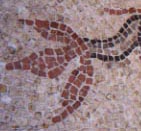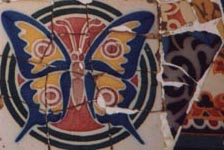Pique assiette - nothing new?
 Just what is pique assiette mosaic? The short answer is that
pique assiette is a style of mosaic that incorporates pieces of
broken ceramics - plates, dishes, cups, tiles - and other found
objects into the design. The longer answer, to think about the
appeal and expressiveness of pique assiette, must take in ideas
of lateral thinking, humour, the art of recycling, and the significance
of found objects.
Just what is pique assiette mosaic? The short answer is that
pique assiette is a style of mosaic that incorporates pieces of
broken ceramics - plates, dishes, cups, tiles - and other found
objects into the design. The longer answer, to think about the
appeal and expressiveness of pique assiette, must take in ideas
of lateral thinking, humour, the art of recycling, and the significance
of found objects.
The basic idea is an old one. Roman mosaicists used pieces
of terracotta vessels to obtain red colours in their work and
also glass from broken bottles. In Britain, fragments of the
red-glazed Samian ware (imported from Gaul) were used. Any busy
mosaic workshop would surely have scavenged and stockpiled the
otherwise worthless broken items, rather than buying them when
needed.
 There is a long tradition of using discarded materials in
the creation of something new. This is particularly true of building
materials, but a prime case of the pique assiette principle is
in the reconstruction of medieval stained glass.
There is a long tradition of using discarded materials in
the creation of something new. This is particularly true of building
materials, but a prime case of the pique assiette principle is
in the reconstruction of medieval stained glass.
A large number of glass windows were deliberately destroyed
during religious upheavals such as the Reformation or the Puritanism
of the English Civil War. In many instances the fragments were
re-assembled into new windows, such as Winchester
Cathedral's West Window, or the Erpingham Window at Norwich
Cathedral (right). The challenge to create something new, spectacular
and meaningful from the precious shards was addressed in different
ways at different sites.
There are examples on a domestic scale too. "Putty pots", popular in Victorian times, were jugs, plates or other household items spread with a layer of putty or plaster. Various personal "treasures", such as pieces of crockery, jewellery or glass would be pressed into this and allowed to set in place. Also of note are African funeral traditions of decorating gravesites and "mourning vessels" with items recalling the life that had passed. These might include crockery and trinkets. The artefacts used in these examples had a particular significance, because they were specially selected and related directly to the maker or the mourned person.
 This folk art practice crossed over
into the world of "formal" architecture in Barcelona
in the early 20th century, thanks to the architect Josep Maria
Jujol. Jujol was collaborating with GaudÌ on the Guell
Park (constructed between 1900 and 1914) and took responsibility
for the mosaics of the snake-like bench and the ceiling of the
hypostyle "Hall of a Hundred Columns". It was an established
practice (known as trencadis) to use broken, waste tiles as a
cladding to a building - this was a technique well suited to
the curved, organic surfaces GaudÌ designed into his buildings.
This folk art practice crossed over
into the world of "formal" architecture in Barcelona
in the early 20th century, thanks to the architect Josep Maria
Jujol. Jujol was collaborating with GaudÌ on the Guell
Park (constructed between 1900 and 1914) and took responsibility
for the mosaics of the snake-like bench and the ceiling of the
hypostyle "Hall of a Hundred Columns". It was an established
practice (known as trencadis) to use broken, waste tiles as a
cladding to a building - this was a technique well suited to
the curved, organic surfaces GaudÌ designed into his buildings.
Jujol, however, took this to another level. He broke whole
tiles and fitted them to the curves of the structures and also
used tiles he had fired and inscribed himself. In another bold
statement, he incorporated broken coloured bottles, fragments
of a broken china doll and broken plates from his own dinner service.
He created a collage of items personal to him in a style that
has inspired and excited millions of people since then.
More about pique assiette: The origin of the names "pique assiette" and picassiette
Pique assiette and found objects
the joy of shards Mosaics Resource